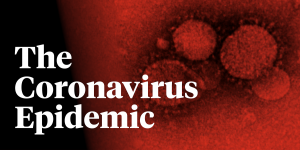The Coronavirus Reveals An Evil Government
The Coronavirus Reveals An Evil Government

 When I was growing up during the 1960s and 1970s, there was one TV in my parents’ home, and there were only three television stations to choose from. The stations were affiliated with the three national networks — ABC, NBC, and CBS. The programming for each of the stations ran from 6:00 AM in the morning until 1:00 AM the following morning. After the last TV program ended at 1:00 AM, there was usually an instrumental patriotic song that was played and then the images on the station were replaced with several thick, horizontal, colored lines that appeared while an annoying audio tone played in the background.
When I was growing up during the 1960s and 1970s, there was one TV in my parents’ home, and there were only three television stations to choose from. The stations were affiliated with the three national networks — ABC, NBC, and CBS. The programming for each of the stations ran from 6:00 AM in the morning until 1:00 AM the following morning. After the last TV program ended at 1:00 AM, there was usually an instrumental patriotic song that was played and then the images on the station were replaced with several thick, horizontal, colored lines that appeared while an annoying audio tone played in the background.
At that point, you had no other choice but to turn off the TV and either occupy yourself with some other activity, or go to bed. Most people went to bed because there wasn’t much more they could do at that time of the night.
When satellite transmission was introduced in the mid-70s, cable TV began to grow. That’s when HBO, TBS, and PBS began broadcasting television programming via satellite. The first cable news network, CNN, was launched in 1980. CNN was the first television network to offer 24-hour news coverage.
Fast-forward 40 years to 2020. We now have access to hundreds of channels that are delivered to us via cable, satellite, and the internet. In addition to the hundreds of television channels, we also have instant access to movies, news, entertainment, sports, and numerous other programs, any time of the day or night. We also have the ability to engage in around-the-clock communication with others through social media. Unlike my teenage years, there is no downtime, and there is never a time when you are forced to shut off your device and go to bed.
We’re always plugged in, and we’re always being stimulated. It’s enough to drive a person crazy. There are hundreds of media outlets that cry out to us and compete for our attention. They have become experts at capturing our attention by providing dramatic coverage of “breaking news” that is designed to instill anxiety and fear.
The Coronavirus has provided a perfect opportunity for individuals and organizations to sensationalize every “news event” that is in any way related to the virus. A person in Seattle dies from the virus and there is dramatic coverage of the “breaking news” of the first U.S. death. That news is quickly replaced with additional virus-related deaths that have occurred in California and Florida. A short time later, Johns Hopkins University announces that more than a 100,000 people around the world have been infected, which causes even more fear and anxiety.
At the end of last week (Friday, March 6th), there was a report that 17 deaths and more than 330 cases of Coronavirus had been confirmed in our country.
Each new report is designed to ramp up the anxiety and fear of our citizens, which causes them to seek out even more information on social media and other available media platforms. The constant drumbeat of fear-induced reporting has caused a snowball effect that has led to numerous events throughout our country being canceled. People are beginning to avoid any place where the virus may be present. Those places include buses, trains, airplanes, concerts, movie theaters, resorts, business meetings and conferences, and any other events where people ordinarily gather.
What do we know so far about the Coronavirus?
After the virus was discovered, the World Health Organization named it COVID-19. By the end of last month (February 2020), more than 82,000 cases of COVID-19 had been confirmed worldwide, with more than 97% of those cases occurring in China. Until recently, it was believed that the mortality rate for COVID-19 was significantly higher than the mortality rate for those who suffer from the standard flu, which kills approximately 56,000 people every year in the United States.
Last week, the New England Journal of Medicine reported that “the overall clinical consequences of COVID-19 may ultimately be more akin to those of a severe seasonal influenza (which has a case fatality rate of approximately 0.1%).”
If this is true, it’s good news for the world.
The way that COVID-19 is transmitted is similar to that of the common cold, which is, face-to-face by sneezing or coughing, or by close contact with the bodily secretions of infected individuals. The COVID-19 virus can survive for up to nine days on surfaces such as doorknobs and shopping carts. Anyone who touches those surfaces and then touches their eyes, nose, or mouth can become infected.
The symptoms of COVID-19 can take as long as 14 days after exposure to appear. This is probably the most dangerous aspect of the virus because carriers of the virus are highly contagious during the time when they are not suffering from any symptoms. Symptoms can include fever, aches and pains, chest pain, fatigue, and a dry cough. Most of the people who have died from the virus were in their 70s, 80s, or 90s, or they were people who already suffered from other medical conditions that compromised their immune systems.
One concern that is greater than the virus itself is the collateral damage that will be caused if there is a significant spread of the virus in our country that requires tens of thousands of people to be treated. Our healthcare system is already pushing up against its limits and could collapse if it is overwhelmed with patients who are suffering from the virus.
A couple of months ago, on a Saturday evening, I took one of my family members to the emergency room at OSF Saint Francis Medical Center. When we arrived, the waiting room was packed with people. The woman behind the counter did her best to avoid telling us what the waiting period was going to be, but we were eventually able to find out that we were going to have to wait for up to four hours before we could see a doctor. There was nothing unusual that was going on that night that I could see. For example, there were no accidents that sent several people to the hospital. The vast majority of the people who were in the waiting room were not in major distress and were not harmed by being forced to wait for treatment.
What if the virus spreads to the extent that everyone fears? Even though there may be only a small percentage of people who die from it, there could be thousands of people who show up in the emergency rooms of local hospitals. The hospitals would be so overwhelmed that there would be no personnel or beds available to care for people who were suffering from acute problems, such as a ruptured appendix, a blood clot, a stroke, or a heart attack.
Last week, I discussed the two proverbs that I thought about when the Coronavirus started spreading: “A little bit of knowledge is a dangerous thing” and “Knowledge is Power.” One fact that I had no knowledge of until the virus began spreading is that 95% of all the antibiotics in the United States come from China.
How can that be? 95% of ALL our antibiotics come from China? How long has that been going on? Did you know anything about this?
It has now become obvious that the greatest threat to our peaceful, free existence is the communist government of China. The best explanation that I’ve heard concerning the political system in China is that the leaders of China are like the mafia. There are more than 10 million men who make up the mafia that runs the government of China. That mafia controls over 1.4 billion people, which is more than four times the population of the United States.
The Chinese mafia rules by fear, force, intimidation, torture, and death. There are no elections and no real freedoms. Couples are told that they can only have one child and women are forced to have abortions when they violate that rule. What would happen if there was a mafia in the U.S. that controlled 95% of our antibiotics? They could demand almost anything they wanted. That’s exactly where we’re at with China.
Last year, during the discussions that arose because of the tariffs that President Trump imposed on China, one prominent Chinese economist — a member of the Chinese mafia — suggested that the Chinese government cut off the United States from its supply of antibiotics. He wanted to use their position as the provider of America’s antibiotics as leverage in their trade negotiations.
Have you heard anything about the choke hold that the Chinese mafia has on our supply of medications?
We need to immediately abandon the entire concept of globalism and aggressively start rebuilding our country by making the things we need. If we don’t do that, we will always be subject to the whims and control of the Chinese mafia and other tyrannical governments.
More on this topic next week.




1 Comment
[…] Next week, I’ll share some “power” (knowledge) with you by telling you everything you need to know (at the moment) about the coronavirus. print […]